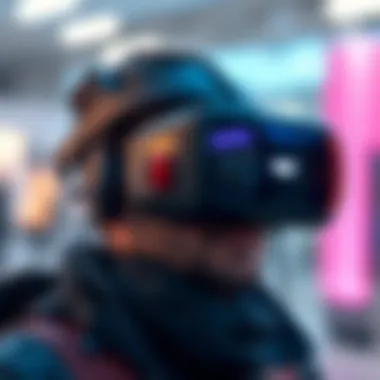Key Differences Between Augmented Reality and Virtual Reality


Intro
The world we live in today is increasingly influenced by technological advancements, particularly in the realms of augmented reality (AR) and virtual reality (VR). While both terms often come up in conversations about the future of technology, their meanings and applications are unique and distinctly different. This article aims to clarify these gaps, helping investors, tech professionals, educators, and enthusiasts alike understand what sets AR apart from VR.
Both augmented and virtual reality utilize advanced technologies to enhance user experiences, but they approach the enhancement of reality in contrasting ways. By delving into their specific functions, applications, and user perceptions, we create a clearer picture that can aid in grasping where each technology fits within the broader digital landscape. Ultimately, distinguishing between these two can greatly influence how one interacts with new digital content now and in the future.
Let’s start peeling back layers to understand these technologies one by one.
Understanding Augmented Reality
In an era where the boundaries between the physical and digital worlds are blurring, understanding augmented reality is essential. This technology superimposes digital information onto the real world, enhancing our perception of our surroundings. As emerging tech finds its way deeper into various sectors, recognizing AR’s potential is critical in evaluating its influence on daily life and business operations.
Augmented reality cultivates experiences that were once relegated to the realm of science fiction. As we dive into this section, the focus will be on communicating what AR means, its historical pathway, the technologies fueling its rise, and the diverse applications transforming industries.
Defining Augmented Reality
Augmented reality stands out through its ability to overlay digital elements onto the physical world. Unlike virtual reality, which immerses users in a completely digital environment, AR interacts with one’s surroundings in real-time. Picture yourself strolling through a city with an AR app on your smartphone that displays historical data about buildings as you pass by them. Essentially, it enhances reality rather than replacing it. This uniqueness makes AR a versatile tool across different fields, from education to medicine.
Historical Development
The journey of augmented reality is intriguing, reflecting a gradual progression from theory to real-world applications. Its conceptual roots trace back to the 1960s when Ivan Sutherland created the first head-mounted display system. However, it wasn't until the late 20th and early 21st centuries that the technology began gaining traction, driven by the advent of smartphones and improvements in computer vision. AR started with static images but has evolved to include sophisticated systems like Microsoft’s HoloLens and various mobile apps that utilize the capabilities of modern devices.
Core Technologies Behind AR
Behind the magic of augmented reality are several core technologies. These include:
- Computer Vision: This allows devices to interpret and interact with the physical world.
- Depth Tracking: This technology helps in analyzing the environment to place digital objects accurately within it.
- Simultaneous Localization and Mapping (SLAM): Helps in real-time mapping and navigation for AR experiences.
Such advancements enable more seamless integration between the digital and physical realms, enhancing user experiences significantly.
Common Applications of AR
Gaming and Entertainment
Gaming and entertainment have embraced augmented reality, leading to interactive experiences that marry the digital and physical. Games like Pokémon GO have shown how AR can cause people to engage more with their environment. This unique aspect turns the entire world into a playground, encouraging physical activity while enhancing social interaction. However, despite its popularity, challenges arise in terms of user safety and privacy, factors that need careful consideration.
Education and Training
AR revolutionizes the education sector by providing immersive learning experiences. Imagine a student studying biology who can use an AR app to explore the human body in 3D. This interactive learning method increases engagement and comprehension, making complex concepts more accessible. The downside lies in the need for technological access and potential disparities in educational opportunities based on location and resources.
Retail and Marketing
In retail, AR helps brands connect better with consumers by enabling virtual try-ons or showcasing products in an interactive way. For instance, IKEA’s app allows users to visualize furniture in their homes before purchasing. This innovation addresses an essential customer need—ensuring that purchases suit their environment. Nevertheless, the success of such applications relies heavily on user willingness to adopt and use the necessary technologies.
Healthcare Innovations
The healthcare sector has also started to capitalize on augmented reality, particularly in surgical procedures. Surgeons can overlay important data during operations, aiding in precision. For instance, AR can display real-time patient information directly on a surgeon's field of view, improving outcomes. Yet, the complexity of integrating AR into existing workflows and training medical personnel to use these systems effectively remains a challenge.
In summary, understanding augmented reality isn't just about knowing what it is; it’s about realizing its far-reaching potential across various industries. Eventually, as we uncover the nuances, we see that AR isn't just a fad; it represents a pivotal shift in how we interact with digital content and our environment.
Understanding Virtual Reality
In today’s digital age, understanding Virtual Reality (VR) is pivotal. As technology continues to push boundaries, VR has emerged not just as a new form of entertainment but also as a vital tool in various sectors, shaping how we perceive and interact with the world. This section delves into VR's fundamental aspects, exploring its intrinsic benefits and potential impacts that could reshape entire industries.
Defining Virtual Reality
Virtual Reality refers to a simulated experience that can be similar to or completely different from the real world. It immerses users in a 3D environment, enhanced by technology that often employs headsets, controllers, or gloves to create the sensation of presence. This immersive experience aims to trick the brain into thinking it is engaged in a different reality—the possibilities are as vast as they are fascinating.
Historical Development


The journey of Virtual Reality can be likened to a rollercoaster ride. It traces back to the 1960s with the development of the Sensorama by Morton Heilig, an early device designed to stimulate multiple senses and provide a thrilling experience. Fast forward a few decades, and we have seen significant advancements with tools like the Virtuality Group's Arcade VR, which brought a glimpse of VR gaming to the masses in the 1990s. Yet, it wasn't until the late 2010s that VR gained significant traction, propelled by technologies such as Oculus Rift and HTC Vive, making the once sci-fi dream a tangible reality.
Core Technologies Behind VR
At the heart of Virtual Reality lies its core technologies. These include:
- Head-Mounted Displays (HMDs): Devices like the Oculus Quest provide the primary visual experience, allowing for a wide field of view and immersion.
- Motion Tracking: This technology enables the system to track the user's movements, translating them into the virtual space, creating a sense of agency.
- Input Devices: Controllers or gloves are utilized to interact with the VR environment, enhancing the realism of the experience.
- Sound Technology: 3D audio plays a critical role in fully immersing users, mimicking sounds from specific directions, much as they would occur in the real world.
Common Applications of VR
Gaming Experiences
Gaming experiences represent a leading application in the Virtual Reality realm. They provide players with an opportunity to dive into entire worlds that feel real and vivid. The unique characteristic here is the level of immersion players achieve, allowing them to not just observe, but actively participate in the narrative of the game. Titles such as Beat Saber and Half-Life: Alyx showcase this capability, enabling players to engage in specific tasks within the VR environment moving beyond traditional gaming. Although VR gaming requires investement in specialized hardware, the appeal and engagement factors keep growing, making it a compelling choice for users seeking deeper connection in gameplay.
Therapeutic Uses
In recent years, VR has found a warm welcome in the healthcare sector. It serves as therapeutic tools, helping patients cope with anxiety, PTSD, and phobias through exposure therapy in a controlled virtual environment. The ability to gradually expose individuals to distressing scenarios in a safe space stands out as a key advantage of this technology. However, integration into mainstream treatment plans requires careful calibration and validation of effectiveness, which remains a challenge for some practitioners.
Architectural Visualization
For architects and designers, Virtual Reality offers the capacity to create full-scale models of buildings and spaces before construction. This application is illuminating as it allows stakeholders to walk through designs and make modifications based on real-time feedback from clients. The key feature is its ability to visualize designs in an interactive manner, providing clarity that traditional blueprints lack. Despite its strengths, the technology demands specialist knowledge, posing some barrier for smaller firms that may lack resources.
Training Simulations
One of the standout benefits of VR lies in its application for training simulations. In fields such as aviation, military, and medicine, VR provides a hands-on training environment without the real-world risks. Simulations allow trainees to practice emergency procedures or intricate surgeries in a lifelike setup. A major asset here is that mistakes can be made with no real-world consequences, offering an unparalleled learning opportunity. However, technical requirements and setup costs may serve as hurdles for organizations looking to implement these systems widely.
VR is not just technology; it has the power to change how we learn, interact, and experience reality.
By dissecting these vital components and applications of Virtual Reality, we draw closer to understanding its potential to revolutionize not just entertainment, but how we operate in varied professional landscapes. The more informed we are about its implications, the better we can harness its capabilities in our pursuits.
Comparative Analysis of AR and VR
Understanding the comparative analysis of Augmented Reality (AR) and Virtual Reality (VR) is crucial for anyone looking to navigate the ever-evolving tech landscape. These technologies are not just buzzwords; they're shaping industries and user experiences in profound ways. By examining the unique aspects of AR and VR, we uncover their characteristics, applications, and limitations, providing insights that can inform investments, innovations, and educational approaches. This analysis will outline the pivotal nuances that separate these immersive technologies while also highlighting their intersections.
Key Differences
User Experience
User experience (UX) stands at the forefront of any technology's success. In the case of AR and VR, the experience diverges sharply:
- Augmented Reality enriches the real world with digital elements, making it a more integrative experience. Users can interact with both the physical and digital realms seamlessly. This duality allows for applications like Pokémon GO, where digital characters relate to real-world locations, enhancing user engagement.
- Virtual Reality, on the other hand, plunges users into a fully fabricated environment, often requiring a headset to completely block out the real world. This immersive experience can lead to profound engagement, especially in gaming and simulations.
Each approach offers distinct advantages and some challenges. AR's blend of the familiar with the new can be less intimidating for first-time users. However, VR can create more potent emotional responses due to its immersive nature, albeit at the cost of requiring more substantial hardware.
Technological Requirements
The technical underpinnings of AR and VR are noteworthy:
- AR applications typically demand less power and can function on standard mobile devices equipped with cameras. The technology often hinges on sensors and software overlaying images onto the real world. This accessibility is a key selling point for widespread adoption, particularly in retail and education.
- In contrast, VR has a heavier requirement in terms of hardware, necessitating specialized headsets and sometimes extensive setups with motion tracking. This can create a barrier for entry, impacting the speed and level of user adoption.
Such technological demands create varying ecosystems around AR and VR, where developers and users face different challenges. As a result, the costs and complexity can either be a boon or a bane for companies considering integration of these technologies.
Engagement Levels
While both AR and VR aim to create engaging experiences, their methods differ:
- AR tends to foster social interactions through shared experiences while users remain connected to their physical surroundings. Think of apps like Snapchat, which effectively use AR for face filters, allowing users to engage with friends in a clever and playful manner.
- VR immerses users intensely, often resulting in a solitary experience but one that deeply affects how users perceive their environment. This can be incredibly beneficial in therapy or training simulations, where concentrated focus can lead to mastery over skills or therapeutic breakthroughs.
Readers should realize that the choice between AR and VR experiences can depend on the context and specific task at hand, illuminating how each can enhance user engagement in its own right.
Overlap and Intersection


Even with critical differences, a gray area exists where AR and VR intersect. Mixed Reality (MR), for instance, blends both technologies to create enriched environments that combine real and virtual worlds. This synergy opens doors to novel applications that can lead to innovative solutions in various fields. The potential in areas like collaborative workspaces or advanced training is vast, as users can leverage both AR and VR to their advantage.
Challenges Facing Each Technology
The paths for AR and VR are not without their bumps:
Technical Limitations
While AR and VR technologies advance, their development still faces hurdles:
- AR can suffer from issues like latency or imprecise positioning, which might lead to a disjointed experience. Technical limitations can hinder the fluid integration of digital elements into the real world.
- VR often falters on accessibility, as the requirement for high-end hardware can isolate potential users. Moreover, the phenomenon of motion sickness remains a significant concern, impacting user enjoyment and safety.
These technical barriers are pivotal points for developers to address to improve user engagement and integration into everyday life.
User Adoption Barriers
Adoption remains a crucial hurdle across both technologies:
- In AR, the perception that these experiences are mere novelties can stymie growth, with some organizations hesitant to invest without proven ROI.
- For VR, the high cost associated with hardware and the need for expansive space can deter consumers. Additionally, fear of motion sickness or discomfort with devices can result in significant non-adoption.
Understanding these barriers offers insights into what needs to be tackled to foster growth in AR and VR industries, paving the way for improved tools to draw in a wider audience.
The Impact of AR and VR on Different Industries
The influence of Augmented Reality (AR) and Virtual Reality (VR) spans various sectors, reshaping how industries operate and interact with consumers, employees, and products. Both technologies have transcended stereotypical uses, transitioning from niche innovations to integral components of business strategy. This section delves into the transformative role of AR and VR in different industries, elucidating specific benefits and considerations that these technologies bring to the forefront.
Entertainment and Media
In the realm of entertainment, AR and VR have redefined user experiences. With AR, applications like Pokémon GO have created immersive environments that blend real-life settings with digital elements, allowing users to catch virtual creatures in their own neighborhoods. Meanwhile, VR has birthed entirely new forms of entertainment, with platforms providing immersive gaming experiences that transport players into fantastical worlds.
Considerations include:
- Consumer Engagement: Enhanced interactivity keeps audiences gripped.
- Content Creation: Storytelling is evolving; narrative techniques must adapt.
- Monetization Opportunities: New revenue streams through virtual goods or experiences.
Education and E-Learning
The educational sector sees a marked improvement in engagement levels with the integration of AR and VR. Traditional learning methods, often perceived as mundane, are being overhauled by these dynamic technologies. AR applications can overlay information on textbooks, making learning more interactive, while VR can simulate complex environments, such as historical events or intricate scientific processes, for an immersive learning experience.
Key aspects to consider include:
- Accessibility: Students can learn at their own pace, regardless of location.
- Retention Rates: Immersive learning can lead to better retention of knowledge.
- Safe Learning Environments: VR provides risk-free scenarios for medical or technical training.
Healthcare and Therapy
In healthcare, AR and VR are proving to be invaluable tools. Surgeons use AR for real-time overlays during procedures, enhancing precision. Moreover, VR is finding its niche in therapy—exposure therapy for phobias can be conducted in controlled environments. Both technologies lend themselves to training medical professionals, impact patient care, and improve health outcomes.
- Patient Empowerment: Patients can visualize their treatment plans through AR.
- Training Enhancement: Realistic simulations for practicing techniques.
- Therapeutic Benefits: VR can reduce anxiety and improve mental health outcomes.
Manufacturing and Design
In manufacturing and design, AR and VR streamline processes, increase efficiency, and foster innovation. Design teams can collaborate in virtual spaces, visualizing products before they are built. AR can assist in maintenance and repair tasks, providing technicians with visual guides. The technology's ability to visualize complex data helps businesses optimize their workflows.
Considerations include:
- Cost Reduction: Improves time management leading to lower costs.
- Enhanced Collaboration: Teams across the globe can work seamlessly together.
- Product Testing: VR allows for virtual prototypes reducing material waste.
Real Estate and Virtual Tours
In real estate, AR and VR are game-changers. Virtual tours allow potential buyers to explore properties without stepping foot inside, saving time and resources. Real estate agents can present properties dynamically, engaging buyers with enhanced visuals and interactive floor plans.
Benefits present include:


- Wider Audience Reach: Buyers can view listings from anywhere at their convenience.
- Perceived Value: Unique presentations can increase interest and perception of property value.
- Efficiency in Sales: Reducing time spent on physical viewings boosts productivity.
As AR and VR technologies advance, they will continue to leave an indelible mark across these domains. While challenges remain—such as the need for robust infrastructure, addressing privacy concerns, and overcoming resistance to change—the potential advantages are vast. Both AR and VR are not just tools; they represent a paradigm shift in how we engage with diverse industries, turning the ordinary into the extraordinary.
The integration of AR and VR into various industries heralds a new chapter of innovation, where interaction becomes experience, and possibility is endless.
For further reading, visit Wikipedia and Britannica.
Future Trends in AR and VR
The rapid evolution of both Augmented Reality (AR) and Virtual Reality (VR) has changed how we interact with technology. The future trends in these areas highlight not just advancements but also the transformative potential they hold across various industries. Keeping an eye on these developments is crucial as investors, educators, and tech enthusiasts seek to navigate this digital landscape.
Exploring how these technologies will continue to grow can mean the difference between getting ahead of the curve or lagging behind in a fast-paced world. Let's unpack the the major components driving the shifts in AR and VR.
Technological Advancements
Technological advancements are key to fostering the growth of AR and VR. The continuous improvement of hardware and software plays a significant role in enhancing user experiences. For instance, lightweight headsets like the Meta Quest 3 stand out due to their ergonomic design, while developments in display technologies yield clearer visuals and more realistic interactions.
- Improved User Interfaces: Companies are working on more intuitive interfaces that rely on natural gestures and voice commands. This progress allows users to engage without cumbersome equipment.
- Edge Computing: By reducing latency through edge computing, AR and VR applications can deliver real-time interactions, making experiences smoother and more immersive.
- Affordable Hardware: There's a growing trend toward making VR and AR technology more accessible. This democratization is likely to expand the user base significantly, especially among educational institutions.
Market Growth Predictions
Market analysts predict robust growth for both AR and VR sectors in the coming years. The Global AR market is expected to reach $198 billion by 2025, while VR is also predicted to see exponential growth, potentially tripling its user base by 2024.
Some factors fueling this expansion include:
- Increased Investment: Startups and established companies are pouring resources into R&D, signaling confidence in the long-term viability of AR and VR.
- Mainstream Adoption: As more businesses integrate AR and VR for training, marketing, and customer engagement, these technologies are likely to become even more commonplace.
"The age of immersive technology isn’t just around the corner; it’s already here and expanding faster than we can imagine."
Integration with Emerging Technologies
Artificial Intelligence
The integration of Artificial Intelligence (AI) with AR and VR raises the bar significantly. AI's capacity for data processing enhances both technologies, making them not only smarter but also more user-responsive. With features like machine learning algorithms, systems can adapt to individual user behaviors, tailoring experiences uniquely to them. One of the standout benefits is the ability to predict user actions, allowing for a more personalized engagement.
A unique feature of AI is its capacity for image recognition. This enables AR applications to overlay digital content onto real-world settings seamlessly. Although beneficial overall, the reliance on vast amounts of data can pose privacy concerns, which stakeholders must navigate carefully.
Blockchain Applications
Blockchain technology is stepping into the AR and VR scene by enhancing security and trustworthiness. Transactions in virtual environments can be safeguarded through blockchain, which provides a decentralized ledger that minimizes the risk of fraud. Moreover, digital ownership is easier to establish and verify, especially important as the metaverse concept gathers momentum.
One of the key characteristics that highlight blockchain's value in this domain is its transparency. Users can engage with AR and VR platforms, confident their data and transactions are safe. However, slow transaction speeds on some blockchain systems could deter users, demanding solutions from developers interested in high-performance interactions.
Important resources for further reading include Wikipedia on Augmented Reality, Britannica AR, and community discussions on Reddit to gather wider perspectives on these enhancements.
In summary, understanding the future trends of AR and VRcould be vital for anyone wanting to be a player in the space. Keeping a pulse on technological advancements, market growth predictions, and integrations with AI and blockchain will help ensure you are not just chasing trends, but leading the charge.
Ending
In this investigation of Augmented Reality (AR) and Virtual Reality (VR), it’s apparent that understanding the nuances between these two technologies is of utmost importance. Both fields are bustling with innovation, reshaping various sectors, from education to healthcare, and their implications are profound.
Unlike conventional interfaces, AR enhances the environment by overlaying digital information, while VR immerses users entirely in a simulated space. This fundamental difference is key to grasping how consumers and businesses alike can leverage these technologies.
The benefits of embracing AR and VR are multiple:
- Enhanced Engagement: Businesses can captivate users like never before, fostering a more dynamic interaction.
- Training and Simulation: For educators and professionals, these tools offer realistic and safe environments for learning and practice.
- New Market Potential: Investors and companies can tap into emerging markets, positioning themselves ahead of the curve.
However, straightforward adoption is riddled with challenges. Developers must navigate issues like
- User Adoption Barriers: Not everyone is particularly keen on new tech, and getting buy-in is essential for success.
- Technical Limitations: The hardware needed for optimal experiences can present a significant hurdle, with costs and accessibility being primary concerns.
"Both AR and VR stand on the threshold of revolutionizing our interaction with digital content, yet their success will depend on overcoming the challenges that lay ahead."
Going forward, as both technologies continue to evolve and merge with areas like AI, practitioners and users must remain informed about their capabilities and implications. Understanding where AR and VR can take us not only informs better decision-making but also prepares industries for the next wave of technological transformation.
In synthesis, this discussion underscores the significance of recognizing the strengths and limitations of each technology. A clear understanding fosters smarter investments and innovative applications that can change the way we perceive and interact with our world.















